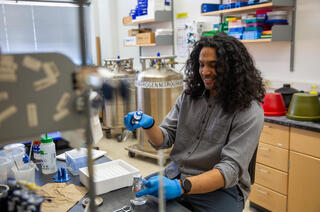Researchers pinpoint bottlenecks that limit microbial production of biofuel, chemicals

Study combined genetic engineering and quantitative analyses to identify enzymes that enhance the conversion of sugar to building blocks of advanced biofuels and other products.
The Science
Zymomonas mobilis is a type of bacteria that’s good at making alcohol. It can also be engineered to produce isoprenoids, a group of chemicals used to make biofuels, medicines, flavorings, and other valuable products. But scientists don’t fully understand the biological bottlenecks that can slow isoprenoid production, which limits industrial uses for this bacteria. For this experiment, researchers created different strains of the microbe that produced more of certain enzymes to see which ones improved isoprenoid production.
The Impact
Produced by most plants, isoprenoids are responsible for coloring, scents, and protecting plants from disease and insects. People can use them to make flavorings, medicines, and farm chemicals as well as sustainable replacements for fossil fuels. Zymomonas rapidly converts the sugars in plant cells into ethanol, and it doesn't seem to be bothered by the toxins in solutions of broken down plant matter that can slow microbial growth. These traits make it a good candidate for making isoprenoids. Identifying the isoprenoid production bottlenecks represents an initial step toward using these bacteria for industrial production.
Summary
In order to understand the metabolic bottlenecks that limit isoprenoid production, scientists with the Great Lakes Bioenergy Research Center combined genetic engineering and quantitative analyses. They systematically engineered strains of Zymomonas to produce more of certain enzymes, or proteins that speed up the metabolic process.
By measuring changes in the level of metabolic intermediates, or molecules that can be converted to isoprenoids, researchers were able to identify the primary enzyme limiting carbon metabolism as well as secondary bottlenecks that occurred when levels of the first enzyme were increased, or overexpressed. These insights can be leveraged to inform future studies seeking to fine tune the expression level for various enzymes in order to maximize the amount of carbon that can be processed while minimizing stress on the bacteria.
Contact
Daven Khana
University of Wisconsin–Madison
khana@wisc.edu
Daniel Amador-Noguez
University of Wisconsin–Madison
amadornoguez@wisc.edu